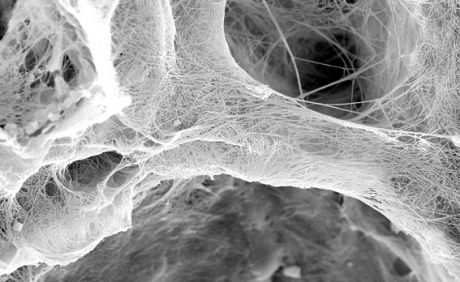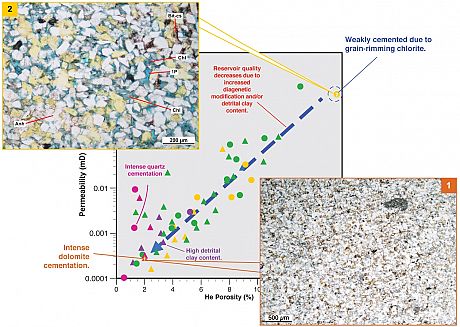
Quantitative and Qualitative Petrography Tailored to the Study
The following provides a summary of the methodology commonly used to collect, interpret and integrate petrographical data for reservoir quality evaluation. This methodology is tailored specifically to the project and data.
• Conventional core analysis data, coded by sedimentological descriptors (lithotype, facies, package, reservoir horizon etc.), are plotted on the 1:200 scale well summary sheet(s), which makes direct comparison between the core sedimentological log, wireline (BHI if available) and core analysis data intuitive.
• Quantitative modal (conventional or Touchstone-compliant) and textural analysis (long grain axis measurements) form the basis for pore-scale reservoir quality assessment. Touchstone-compliant data, suitable for subsequent use in diagenetic modelling, includes the quantification of grain coat coverage.
• Focused thin-section descriptions provide documentation of rock texture and fabric, detrital and authigenic mineralogy, paragenesis and pore system make-up, as appropriate for the aims of the study. This is supported by a focussed in-depth review of pore system characteristics, as well as clay composition and morphology, using up-to-date secondary electron and backscattered SEM imaging and EDX element detection systems.

One-stop Integrated Reservoir Quality Information
All descriptive rock observations, summary modal and textural data, XRD results and any associated sample-based data, such as poroperm, MICP, high-resolution sample scans, thin-section, as well as relevant SEM photomicrographs, are integrated in a searchable database.
• The searchable petrological database (Access) either forms a direct deliverable, for client in-house use, or is used to produce high quality, integrated sample description hardcopy outputs, forming a powerful one-stop source of pore-scale reservoir quality information.
• The geological controls on relative rock quality (eg. texture, detrital composition, compaction, authigenic mineralogy etc.) are determined from the interrogation of petrological results and conventional core analysis data (porosity and permeability), coded by sedimentological descriptors and interpretations.
• Variations in the reservoir quality attributes, in both the stratigraphic and lateral sense and in poroperm cross-plots, are investigated. Rock quality mapping/rock typing is routinely undertaken if considered appropriate, and factors of potential interest for the prediction of formation damage are highlighted in the integrated report.
• Technical Assurance of all petrographical/reservoir quality data and interpretations, assessed via a rigorous quality management system.

We believe that the best reservoir models are generated via the integration of data gathered from a variety of different techniques. This high resolution A3 poster shows just how we go about producing these models. (7.0mb)

Case Studies
The following case studies may be of interest:

Articles
The following articles may be of interest:

Publications
The following publications may be of interest:
- New Insights on the Mauddud Formation (Upper Albian): Characterisation of Sedimentology, Diagenesis and Reservoir Quality
- The impact of carbonate texture on the quantification of total porosity
- Pore-scale fabric as a tool to distinguish in situ from remobilised mudrocks in deepwater deposits
- Field-Scale Reservoir Quality Variations and Predictability in Uncored Intervals within the Arab Formation, offshore Abu Dhabi (United Arab Emirates)
- Morphometry of micrite particles in cretaceous microporous limestones of the Middle East: Influence on reservoir properties

